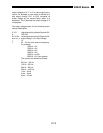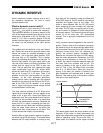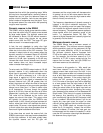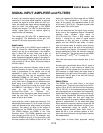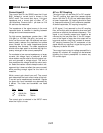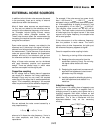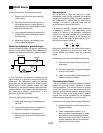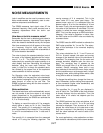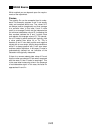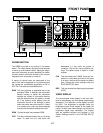
3-23
SR850 Basics
Random noise finds its way into experiments in a
variety of ways. Good experimental design can
reduce these noise sources and improve the
measurement stability and accuracy.
There are a variety of intrinsic noise sources which
are present in all electronic signals. These sources
are physical in origin.
Johnson noise
Every resistor generates a noise voltage across its
terminals due to thermal fluctuations in the elec-
tron density within the resistor itself. These fluctua-
tions give rise to an open-circuit noise voltage,
where k=Boltzmann's constant (1.38x10
-23
J/°K),
T is the temperature in °Kelvin (typically 300°K), R
is the resistance in Ohms, and ∆f is the bandwidth
in Hz. ∆f is the bandwidth of the measurement.
Since the input signal amplifier in the SR850 has a
bandwidth of approximately 300 kHz, the effective
noise at the amplifier input is V
noise
= 70√R nVrms
or 350√R nV pk-pk. This noise is broadband and if
the source impedance of the signal is large, can
determine the amount of dynamic reserve
required.
The amount of noise measured by the lock-in is
determined by the measurement bandwidth.
Remember, the lock-in does not narrow its detec-
tion bandwidth until after the phase sensitive
detectors. In a lock-in, the equivalent noise band-
width (ENBW) of the low pass filter (time constant)
sets the detection bandwidth. In this case, the
measured noise of a resistor at the lock-in input,
typically the source impedance of the signal, is
simply
The SR850 displays the ENBW in the TIME
CONSTANT menu. This is the correct noise band-
width for the time constant and the number of
poles and should be used to calculate the detect-
ed Johnson noise. The displayed ENBW does not
take the synchronous filter into account.
The signal amplifier bandwidth determines the
amount of broadband noise that will be amplified.
This affects the dynamic reserve. The time con-
stant sets the amount of noise which will be meas-
ured at the reference frequency. See the SIGNAL
INPUT AMPLIFIER discussion for more informa-
tion about Johnson noise.
Shot noise
Electric current has noise due to the finite nature
of the charge carriers. There is always some non-
uniformity in the electron flow which generates
noise in the current. This noise is called shot
noise. This can appear as voltage noise when cur-
rent is passed through a resistor, or as noise in a
current measurement. The shot noise or current
noise is given by
where q is the electron charge (1.6x10
-19
Coulomb), I is the RMS AC current or DC current
depending upon the circuit, and ∆f is the
bandwidth.
When the current input of a lock-in is used to
measure an AC signal current, the bandwidth is
typically so small that shot noise is not important.
1/f noise
Every 10 Ω resistor, no matter what it is made of,
has the same Johnson noise. However, there is
excess noise in addition to Johnson noise which
arises from fluctuations in resistance due to the
current flowing through the resistor. For carbon
composition resistors, this is typically 0.1 µV-3 µV
of rms noise per Volt of applied across the resis-
tor. Metal film and wire-wound resistors have
about 10 times less noise. This noise has a 1/f
spectrum and makes measurements at low fre-
quencies more difficult.
Other sources of 1/f noise include noise found in
vacuum tubes and semiconductors.
Total noise
All of these noise sources are incoherent. The
total random noise is the square root of the sum of
the squares of all the incoherent noise sources.
INTRINSIC (RANDOM) NOISE SOURCES
V
noise
(rms) = 4k TR∆f
( )
1/2
V
noise
(rms) = 0.13 R ENBW nV
I
noise
(rms) = 2q I∆f( )
1/2



